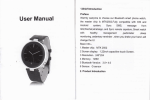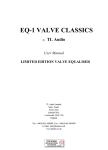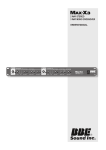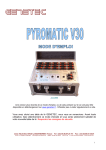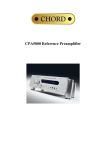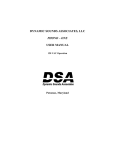Download B&K Pro10 Specifications
Transcript
Table of contents Safety precautions page 3 Introduction page 4 Front panel view page 5 Front panel description page 6 Record page 6 Select page 6 Tape Monitor page 6 Direct Bypass page 6 Power Switch (Mute) page 6 Headphone page 6 LED page 6 Balance page 7 Volume page 7 Stereo/Mono page 7 Back panel view page 8 Back panel description page 9 Balanced Preouts page 9 Page 1 Unbalanced Preouts Tape Monitor Loop page 9 page 9 Line Level Inputs page 9 Phono Inputs page 9 Phono Ground page 10 Power Connection page 10 Phono Stage Configuration page 10 MM/MC selection page 10 Capacitive Loading page 10 Resistive Loading page 11 Tables page 12 Block diagram page 13 Making the connection page 14 Troubleshooting page 15 Specifications page 16 Warranty page 17 Accessories Included : Power cord, Power supply, Owners Manual Page 2 SAFETY PRECAUTIONS PLEASE READ BEFORE INSTALLING • Turn preamplifier ‘off’ when plugging in or unplugging input and speaker cables!!! • When plugging in or unplugging interconnect cables running from source to preamplifier, always mute the preamplifier and rotate the preamplifiers volume control to minimum first. It is recommended that you turn the amplifier ‘off’ as well for this operation. • The PRO10 is equipped with raised feet so that continuous ventilation can be maintained. They help to maintain acoustic feedback into the amplifier at a minimum. They also provide a measure of protection against scratching any surface the unit might be resting on. Do not alter or remove them. • Do not stack anything on top of the preamplifier (processor, source...etc.). Page 3 Introduction Thank you for selecting B&K Components, Ltd.’s PRO10 preamplifier. The PRO10 is designed for the discriminating audiophile. The PRO10 is a DC coupled preamplifier that has been designed using all discrete circuit topology with a switchable head amp on the phono stage. Gold-plated premium connectors have also been utilized to minimize degradation in the signal path. The PRO10 has an external power supply that should be connected to an unswitched AC source. In order to obtain maximum performance from this unit, Please read these instructions very carefully. Features FET loading - Maximizes linearity and minimize noise. Wide bandwidth - Assure clear reproduction with all styles of music. Polypropylene film capacitors - RIAA accuracy typically within ± .2 dB through the use of polypropylene film capacitors. This produces a transparent sound with highly accurate musical timbre. Volume control - From a single precision attenuator. Accuracy of volume attenuation is within .1 dB from channel to channel. 1% Metal Film resistors - Low noise resistors for better sound and a greater degree of repeatability. Also: Direct output capability All discrete predriver circuitry Premium gold-plated connectors Separate source and record selectors Balanced outputs standard Page 4 Front panel view 1. 2. 3. 4. 5. 6. 7. 8. 9. 10. Record selector knob Source selector knob Tape monitor button Direct bypass button Power switch (mute switch) Headphone jack Power on LED Balance knob Volume knob Mono/Stereo selector button Page 5 Front panel description RECORD - Controls which one of the six input pairs is routed directly to the record output connectors (REC OUT). The selected input signal bypasses the remainder of the preamplifier’s circuitry to provide the purest possible recording source. SELECT - Controls which one of the six input pairs is routed to the processing circuitry and then to the preamplifier output connectors (PRE AMP OUT). The signal made available at these connectors is used to drive the external power amplifiers. TAPE MONITOR - The tape monitor switch allows the tape deck connected to the tape monitor inputs (TMON IN) to be routed to the processing circuitry and then to the preamplifier’s output connectors (PRE AMP OUT) independent of the position of SELECT. The input signal selected via SELECT remains valid but is overridden while the TAPE MONITOR switch is in the ON position (switch pushed in). Turning the TAPE MONITOR off (switch pushed out) restores the input signal determined by the SELECT position. DIRECT BYPASS - POWER SWITCH - HEADPHONE - LED - The DIRECT BYPASS switch selects the active or passive mode. In the active mode (switch out) the selected signal is processed through a 20 dB DC coupled amplifier. The passive mode (switch in) bypasses the gain stage of the preamplifier. The power switch is actually a mute switch. This switch changes the mode of the preamplifier. With the switch on, LED illuminated, the signal is passed from the source to the amplifier. With the switch off, LED off, the source is passed to the headphone jack. Stereo headphones having a standard ¼ inch binaural plug can be connected to the headphone output. The mute switch must be in the off position for the headphone output to be enabled. Indicates which mode the preamplifier is in. When the LED is illuminated the preamplifier passes the selected source to the outputs of the preamplifier to the amplifiers. When the LED is off the preamplifier passes the selected source to the headphone jack. Page 6 BALANCE - The balance control is used to adjust the relative volume of the left and right channels. This affects the PRE AMP OUT connections and the headphone output. VOLUME - STEREO MONO - Turning the volume control clockwise increases the volume level, counterclockwise decreases the volume level. The stereo/mono switch selects the mode in which the incoming signals are processed through the preamplifier. Stereo mode (switch out) provides normal stereo reproduction, monaural signals will be reproduced in mono. Mono mode (switch in) reproduces both stereo and mono signals in monaural. Page 7 Back panel view 1. 2. 3. 4. 5. 6. 7. Balanced pre-outputs Unbalanced pre-outputs (RCA) Tape monitor loop Line level inputs Phono inputs Phono Ground connection Power connection for external power supply Page 8 Back panel description BALANCED PREOUTS - For use with balanced output cables when your amplifier has balanced inputs. The balanced outputs will help improve the quality of sound being reproduced by the amplifier when there is a long run between the amplifier and the preamplifier. Balanced connector cable end UNBALANCED PREOUTS - Standard RCA outputs to connect patch cables to amplifiers. RCA connector cable end TAPE MONITOR LOOP For connection of your tape recorder. LINE LEVEL INPUTS Line level inputs are for connecting your source components to the system. (CD, Tape, Tuner,... etc.) PHONO INPUTS - Phone inputs are for the connection of a turntable. These inputs are switchable which allows them to be configured for a moving magnet or moving coil cartridge. Phono stage - The phono stage of the PRO10 may be configured for either Moving Magnet (MM) or Moving Coil (MC) applications with the additional capability to set the resistive and capacitive loading of the phono cartridge. NOTE: Your PRO10 has already been configured for a MM stage with a resistive loading of 50 Kohms and you need not perform any modifications unless you so desire. To reconfigure your PRO10, follow the appropriate procedure listed on page 10. Page 9 PHONO GROUND - For connection of your ground wire for phono use. POWER CONNECTION - For connection of the included power supply. ** Caution must be taken when connecting the included power supply. Do not force the plug as you may damage the pins inside the preamplifier. The plug is keyed so you can only insert it in one orientation. **NOTE - USE ONLY B&K COMPONENTS POWER SUPPLY. Phono Stage Configuring Select Moving Magnet (MM) or Moving Coil (MC) 1. Locate the 2 position push button switch on the inside of the unit (see figure 1). It is located near the back left side. The switch can be identified by a metal tab at the end which indicates whether MM or MC is selected. 2. Push the switch in to select the type of phono stage that is desired (MM/MC). The switch “toggles” the selected stage between MM and MC each time the switch is depressed. NOTE: The PRO10 is shipped from the factory with the phono stage set to the MM configuration and a resistive loading of 50 Kohms. Selecting the MC stage without changing the resistive loading will result in an effective load of 133 ohms. Capacitive Loading NOTE: The PRO10 is shipped from the factory with no capacitor installed. Typically, the capacitance of the phono cables (C phono cables ) is sufficient and no capacitor is needed. 1. 2. Determine the capacitor value (pF) for proper loading of the MM cartridge in accordance with the specifications of the cartridge you have selected. A recommended value may be suggested by the manufacturer of the cartridge. The capacitive loading affects both the MM and MC stage. The capacitance (C load) should be: Cload = C cartridge - Cphono cables - 75 pF Locate the 2 gold-plated pin receptacles with the label “CLOAD” between them on the inside of the unit (see figure 1). They are located near the left end of the circuit board. Near the MM/MC Page 10 selector switch. 3. Trim the leads of the capacitors (one required per channel) to approximately _ inch. 4. Insert the leads into the CLOAD pin receptacles securely. Resistive Loading NOTE: The PRO10 is shipped from the factory with a 100 Kohm resistor installed and the phono stage MM configuration selected. This resistor should not be removed unless the resistive loading is being changed in accordance with the following guidelines. 1. Determine the resistor value for proper loading of the cartridge in accordance with the specifications of the cartridge you have selected. A recommended value may be suggested by the manufacturer of the cartridge. The resistive loading affects both the MM and MC stage. The resistive loading for the MM stage can be calculated using the following equation: Ri (in Kohms) = (100,000 * Rc) / (100,000 - Rc) Ri = inserted resistor value Rc = cartridge loading value (must not exceed 100Kohms) Kohms = 1,000 ohms example: Rc (desired) = 50 Kohms Ri = (100,000 * Rc) / (100,000 - Rc) Ri = (100,000 * 50,000) / (100,000 - 50,000) Ri = (5,000,000,000) / (50,000) Ri = 100,000 ohms = 100 K ohms (factory installed) The resistive loading for the MC stage can be calculated using the following equation: Ri (in ohms) = (133 * Rc) / (133 - Rc) Ri = inserted resistor value Rc = cartridge loading value (must not exceed 133 ohms) For Ri >> 1300, Rc = 133 ohms example: Rc (desired) = 100 ohms Ri = (133 * Rc) / (133 - Rc) Ri = (133 * 100) / (133 - 100) Ri = (13,300) / (33) Ri = 403 ohms (use 402 ohm standard value resistor) Page 11 NOTE: You may not be able to attain the proper value resistor to fit you application, use the closest standard value you can find. Refer to the following table for more calculated values of MM Rc desired (ohms) 5K 20 K 35 K 50 K 75 K Ri calculated (ohms) Ri standard (ohms) 5.3 K 25.0 K 53.8 K 100 K 300 K 5.36 K 24.9K 53.6 K 100 K 301 K Refer to the following table for more calculated values of MC Rc desired (ohms) 25 45 75 100 125 Ri calculated (ohms) Ri standard (ohms) 30 68 171 403 2.1K 30.1 68.1 169 402 2.10K 2. Locate the 2 gold-plated pin receptacles with the label “RLOAD” between them on the inside of the unit (see figure 1). They are located near the left end of the circuit board and near the MM/MC selector switch. 3. Trim the leads of the resistors (one per channel) to approximately _ inch. 4. Insert the leads into the RLOAD pin receptacles securely. 5. The factory installed resistors in the PRO10 will match most phono cartridges on the market. Page 12 Figure 1 Block Diagram Page 13 Page 14 Making the connection The diagram below shows a typical connection between the preamplifier and a B&K amplifier using the unbalanced RCA outputs. Note: The balanced button on the amplifier must be in the off (out) position. The diagram below shows a typical connection between the preamplifier and a B&K amplifier using the balanced XLR outputs. Note: The balanced button on the amplifier must be in the on (in) position. You may use either of these options to connect your preamplifier to the main amplifier. If you wish to connect additional amplifiers, you may use both examples or use both sets of PREAMP OUTS. Page 15 Page 16 PRO10 Specifications Moving Coil Sensitivity (at 1kHz) .09 mV Moving Coil Overload (at 1kHz) 17 mV Moving Coil Load Resistance Variable Moving Coil Load Capacitance Variable Moving Coil (S/N A Weighted) 70 dB Moving Magnet Sensitivity (at 1kHz) .8 mV Moving Magnet Overload (at 1kHz) 225 mV Moving Magnet Load Resistance Variable Moving Magnet Load Capacitance Variable Moving Magnet (S/N A Weighted) 82 dB THD .02 % IM Distortion (SMPTE) .02 % Frequency Response (± 1 dB) 1 Hz - 150 kHz High Level Sensitivity 45 mV Maximum Output 14 V R.M.S. High Level (S/N A Weighted) 89 dB Processor Loops 1 Page 17 Limited Warranty B&K Components Ltd., referred to herein as B&K, warrants your B&K equipment against all defects in material and workmanship for a period of five years from the date of purchase. This warranty applies only to the original purchaser and only to equipment in normal residential use and service. Defective equipment must be returned to B&K, prepaid, accompanied by sufficient payment to cover the cost of return shipping and handling, and will be repaired or replaced at the discretion of B&K whose decision as to the method of reparation will be final. This warranty shall not apply to any equipment which is found to have been improperly installed, incorrectly fused, misused, abused, or subjected to harmful elements, used in any way not in accordance with instructions supplied with the unit, or to have been modified, repaired or altered in any way without the expressed, written consent of B&K. This warranty does not apply to the cabinet, the remote controller, or appearance items such as the faceplate, control buttons, or display lenses, nor does it cover any expenses incurred in shipping the unit to and from the manufacturer’s service depot. No warranty, implied or otherwise created by State law shall extend beyond the terms of this warranty and B&K shall not be liable for any incidental or consequential damage arising out of a defect in material or workmanship of the unit during the terms of this warranty or thereafter. Some States do not allow the exclusion or limitation of incidental or consequential damages and the foregoing exclusions may not apply to you. This warranty gives you specific legal rights. Your may also have other rights which vary from State to State. No agent, representative, dealer or employee of B&K has the authority to increase or alter the obligations or terms of this warranty. B&K Components Ltd. RETURNING EQUIPMENT No equipment may be returned to B&K Components Ltd. Without a RETURN AUTHORIZATION. Should you find it necessary to return equipment to B&K, for any reason, a RETURN AUTHORIZATION (R.A.) number must be issued by B&K in respect of the equipment being returned. You may request an R.A. number by calling B&K at the numbers below. We ask that you provide the following information at that time. 1. 2. 3. Your name, address, and phone number. The model and serial number of the equipment being returned. A description of the problem being experienced. Your call will be referred to a Technical Service Representative who will work with you to resolve the problem. If it is determined that the unit must be returned for repair, an R.A. number will be issued. Customer service hours are 10:00am to 12:00pm and 1:00pm to 4:00pm. B&K Components Ltd. 2100 Old Union Road, Buffalo New York 14227 1-800-543-5252 or 1-716-656-0023 Page 18


















